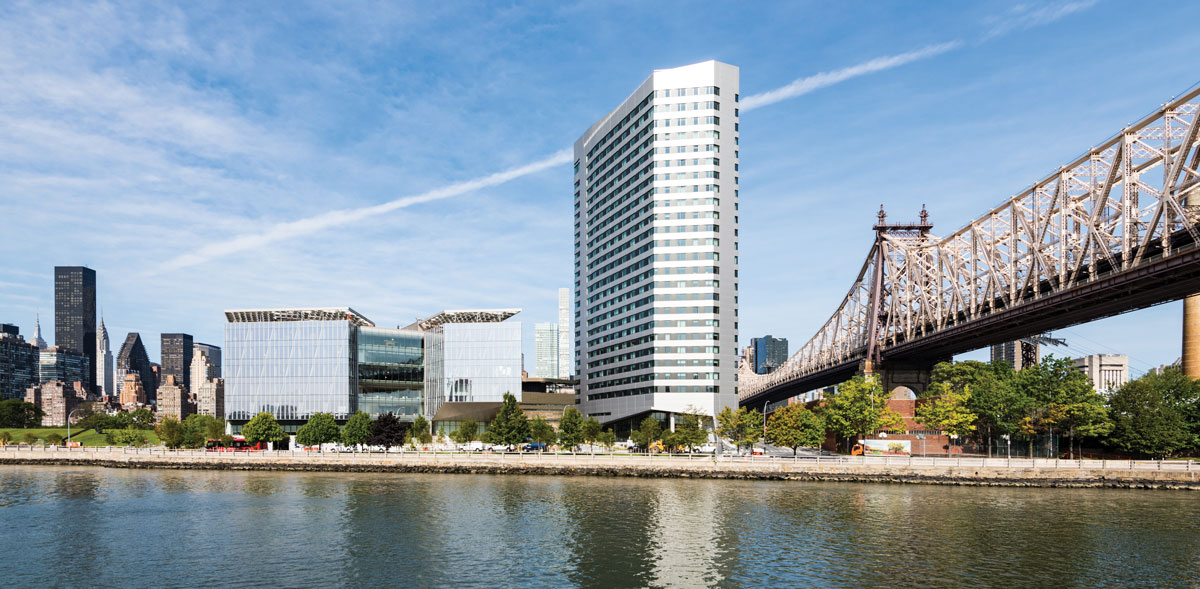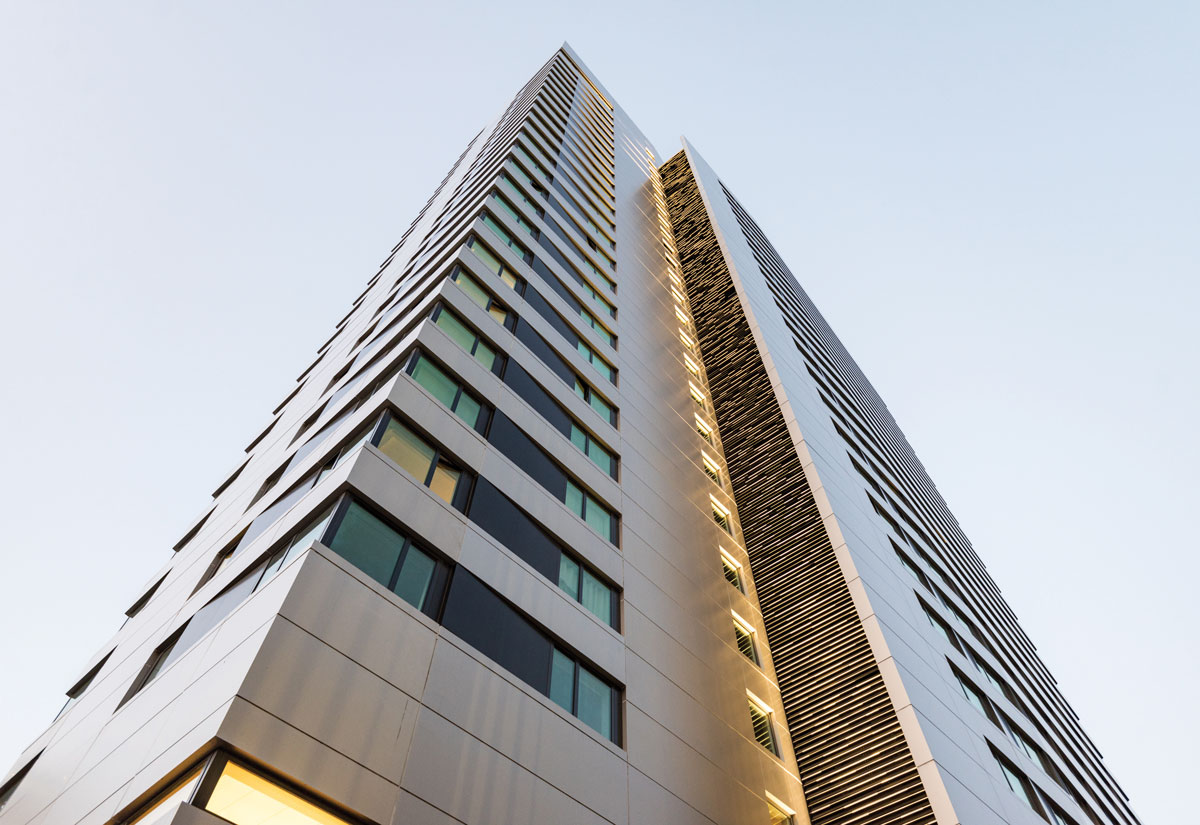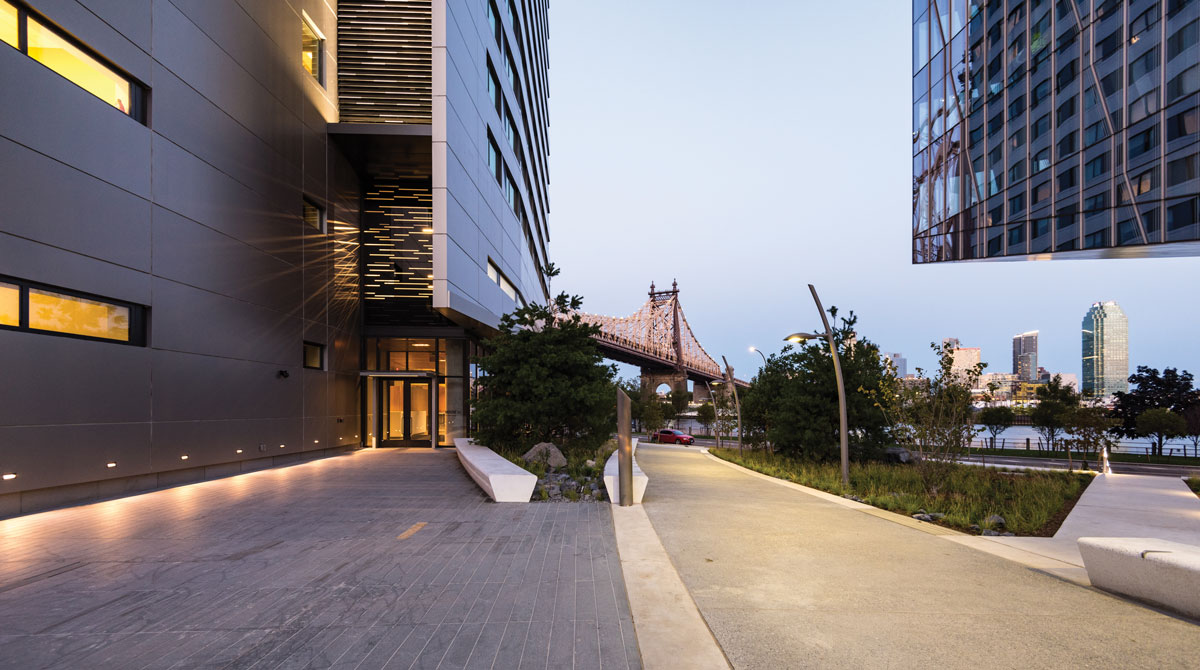
ounded in Pittsburgh in 1883, PPG continually works to grow and develop its industrial coatings business. Now more than ever, the coatings giant works in close collaboration with the community of architects and developers to ensure their structures are distinctive in appearance and protected with strong, durable and colorfast coatings. In 2008, PPG purchased SigmaKalon Group, which manufactured architectural paint, protective and marine coatings, and industrial coatings. In 2013, also it acquired the architectural coatings business of AkzoNobel.
Looking to 2022 and beyond, PPG’s worldwide team of chemists, researchers, specifiers and knowledgeable sales associates is taking the visions of architects and translating them in terms of color schemes, textures and reflectivity.
David Story, PPG chief stylist and manager of color science for building products, along with Gary Edgar, PPG specification manager for building products, discuss how this process works.
The Cornell Tech Residence Tower (also known as the Passive House) sitting on Roosevelt Island in the East River, is one of the high-profile projects that PPG helped to bring to fruition.
According to Story, the facade’s color shifts from silver to champagne with changing light and angles. “Some of the inspiration for more dramatic color changes came from the automotive industry, experimenting with polychromatic effects.” In recent years, he adds, “architects and designers have been gravitating toward multi-dimensional aesthetics. They like the special effects that are mostly available on high-end luxury vehicles.”
University of South Florida’s Genshaft Honors College building is another example. In this case, the color shifts dramatically from copper to verdigris.
Story notes that inspiration also comes from color trends. “We have a global color trend team that meets annually to bring in data and input from various regions and industries. We are honored to work with architects—who are the true superstars. We want to achieve the building skin they envision and bring our signature color capabilities to the buildings they design,” he says.


 [Architects] want a signature piece that will be up for decades. Finding the perfect color plays a big role.
[Architects] want a signature piece that will be up for decades. Finding the perfect color plays a big role. 
ppg building products
Like other design trends, styling for building facades has evolved. The term “styling” used to be associated exclusively with the automotive industry, which designs new colors for future models.
But for skyscrapers, libraries and universities, styling takes on a different definition. “Sometimes an architect does not have a specific color target, just a concept. It is our job to interpret and home in on the color and texture of their design vision. That’s what makes it fun,” says Story.
PPG’s industrial coatings team frequently receives new referrals from architects who have worked with them before. “If they want something out of the catalog, that’s one thing. But it’s becoming more common for architecture firms to want colorscapes that are truly unique and designed for their amazing multi-story building canvas.
“They are working on buildings that will be up for decades, and they want a signature piece. Finding the perfect color plays a big role,” Story explains. “When they seek our advice, one question we ask about is the cityscape: Do they need to pay homage to a background of historic buildings? We have a project in Philadelphia surrounded by magnificent brick buildings, and the architect wanted shifts in painted metal that reflected the brick color scheme.”


a nationwide network.

Our team is here, there and everywhere ready to help when you need it. Let us bring your business the ultimate flexibility and competitive edge so you can deliver the most consistent product to your customers!
“We start by talking with the architects. They will give us a few colors and say they like this but want more or less shimmer and a few different hues,” says Edgar. “We want to give them the right family of colors. It often takes two or three tries to get the right hue, sparkle and sheen.
When PPG formulates a color, “we formulate it for application—for coil or spray—and we work on each process,” he explains. To help get the desired look, PPG has a certified applicator program for both coil coaters and companies that coat aluminum extrusions.
PPG is involved in projects “from cradle to grave,” Story says. “When an architect trusts us to create that color, Gary’s team determines which applications are best for this product. When they order it, we then alert our tech services team, which manages it; we give them the specs and they go out and support it.”

When PPG works with coil coaters and extrusion painters, it performs line audits, checking “the process of the pretreatment, how it’s primed and painted, and random and annual and biannual testing for the application, to make sure it stays on the building, so there is no chipping or fading,” Edgar says.
PPG’s teams are so integrated with paint line operators that they learn how individual pieces of equipment apply the coating and formulate the color “to come out properly,” he says. “Some of the projects have many different applicators and many different applications. We make sure that these colors are consistent through different applications. If we formulate a color for a disc sprayer and someone uses air instead, it won’t come out the same. It is a long process to get all the details correct,” Edgar notes.
When a process fails, “we get involved immediately and figure out what happening and formulate the product to work properly on the line,” he adds.
“What gets challenging is when one applicator must coat a door frame, and another has to coat a wall panel and each has totally different application processes. But the owner expects that the two will match,” Story says.
“Sometimes you even notice differences on higher floors. We’ve had building owners look at their buildings from a helicopter. Deviations are unacceptable,” Edgar says.
Based on PPG’s current list of projects, Story believes more and more architects are taking advantage of the company’s ability to style special colors. “The dramatic color change is so striking. There is a project going up in Seattle that will have color changes related to the client’s brand. Beyond branding and university settings, we are seeing more three-dimensional colors,” he says.
In vogue are “bright or subtle sparkles that look like they are dancing. Some architects are gravitating toward mineral colors, something that we created a couple years ago.” Because they are placing metal panels next to brick, PPG created mineral colors. “In the shade, they look flat like the brick but in bright sunlight, you see a mineral sparkle. Those kinds of earth tone finishes are gaining in popularity,” Story says.
“You can do more with any of our colors, with micas and other effects,” Edgar says, noting that PPG can offer more products that obtain such effects but require fewer coats, which can reduce costs.
Story cites a recent building project in Washington, D.C. The architect wanted an off-white that closely matched historical white brick and stone buildings. PPG created an aged white called Americana White. “The response to that has been so positive that it is now specified on three different projects in Washington, New York and China.”
It has become standard that “clients take what you have, then ask for something more. They want to see their remarkable buildings written up in architectural magazines.”

